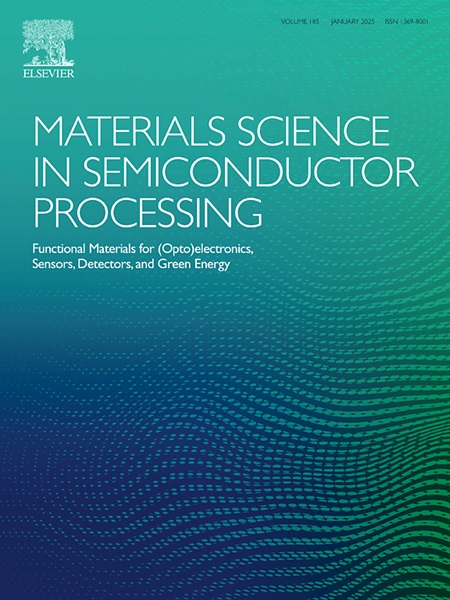pt改性Janus WXY单层作为变压器油中气体(CO2, C2H2, CH4和H2)传感候选材料的研究:a DFT
IF 4.6
3区 工程技术
Q2 ENGINEERING, ELECTRICAL & ELECTRONIC
引用次数: 0
摘要
在这项工作中,密度泛函理论(DFT)深入探讨了溶解气体分析(DGA)在原始和掺杂WXY和Pt-WXY(其中X≠Y=Se,S)单层上的吸附动力学和机理。根据吸附能的计算,在某些体系中加入Pt掺杂剂会引起物理到化学的吸附演化。变压器油中的常见气体(H2、C2H2、CO2、CH4等)可被气体传感器识别并去除,保证变压器的安全运行。利用吸附结构、态密度(DOS)和回收率等指标,系统地研究了气体/Pt-WXY体系的吸附和吸收行为。Pt-WSeS单层对所有气体的显著吸附能力为C2H2 (- 2.22 eV) >;H2(−1.71 eV) >;CO2(−0.86 eV) >;CH4(−0.71 eV),能够去除或检测这些污染物。H2/Pt-WSeS体系在498 K下的恢复时间为11.07s。此外,由于Pt-WSSe单层具有良好的吸附和吸收特性,将成为H2和C2H2传感的可行选择。然而,即使在室温下,Pt-WSSe单层对CO2和CH4分子的无效吸附表明它不是CO2和CH4探测器的合适材料。我们的发现不仅揭示了过渡金属(Pt)掺杂对Janus WXY单层的影响,而且对Pt-WXY表面在电气技术中的可能用途提供了初步的了解。本文章由计算机程序翻译,如有差异,请以英文原文为准。
Investigation Pt-modified Janus WXY monolayer as a possibility sensing candidate for gases (CO2, C2H2, CH4, and H2) in transformer oil: A DFT
In this work, density functional theory (DFT) has been used to thoroughly explore the adsorption dynamics and mechanism of dissolved gas analysis (DGA) on pristine and doped WXY and Pt-WXY (where X≠Y=Se,S) monolayers, respectively. According to the adsorption energy calculation, adding a Pt dopant may cause a physical-to-chemical adsorption evolution for some systems. This gas sensor identifies and removes common gases in transformer oil, such as H2, C2H2, CO2, and CH4, to ensure the transformers operate safely. The adsorption and absorption behaviors for gas/Pt-WXY systems are systematically investigated using the adsorption configuration, density of state (DOS), and recovery property. The significant adsorption capability of Pt-WSeS monolayer towards all gases is C2H2 (−2.22 eV) > H2 (−1.71 eV) > CO2 (−0.86 eV) > CH4 (−0.71 eV), which enables the removal or detection of such pollutants. The H2/Pt-WSeS system has a fast recovery time of 11.07s at 498 K. Furthermore, because of the favorable adsorption and absorption characteristics, the Pt-WSSe monolayer would be a viable option for H2 and C2H2 sensing. Nevertheless, even at room temperature, the ineffective adsorption of the Pt-WSSe monolayer onto CO2 and CH4 molecules indicates that it is not a suitable material for CO2 and CH4 detectors. Our findings not only shed light on the influence of transition metal (Pt) doping on Janus WXY monolayer but also offer an initial understanding of the possible uses of Pt-WXY surfaces in electrical technology.
求助全文
通过发布文献求助,成功后即可免费获取论文全文。
去求助
来源期刊

Materials Science in Semiconductor Processing
工程技术-材料科学:综合
CiteScore
8.00
自引率
4.90%
发文量
780
审稿时长
42 days
期刊介绍:
Materials Science in Semiconductor Processing provides a unique forum for the discussion of novel processing, applications and theoretical studies of functional materials and devices for (opto)electronics, sensors, detectors, biotechnology and green energy.
Each issue will aim to provide a snapshot of current insights, new achievements, breakthroughs and future trends in such diverse fields as microelectronics, energy conversion and storage, communications, biotechnology, (photo)catalysis, nano- and thin-film technology, hybrid and composite materials, chemical processing, vapor-phase deposition, device fabrication, and modelling, which are the backbone of advanced semiconductor processing and applications.
Coverage will include: advanced lithography for submicron devices; etching and related topics; ion implantation; damage evolution and related issues; plasma and thermal CVD; rapid thermal processing; advanced metallization and interconnect schemes; thin dielectric layers, oxidation; sol-gel processing; chemical bath and (electro)chemical deposition; compound semiconductor processing; new non-oxide materials and their applications; (macro)molecular and hybrid materials; molecular dynamics, ab-initio methods, Monte Carlo, etc.; new materials and processes for discrete and integrated circuits; magnetic materials and spintronics; heterostructures and quantum devices; engineering of the electrical and optical properties of semiconductors; crystal growth mechanisms; reliability, defect density, intrinsic impurities and defects.
 求助内容:
求助内容: 应助结果提醒方式:
应助结果提醒方式:


